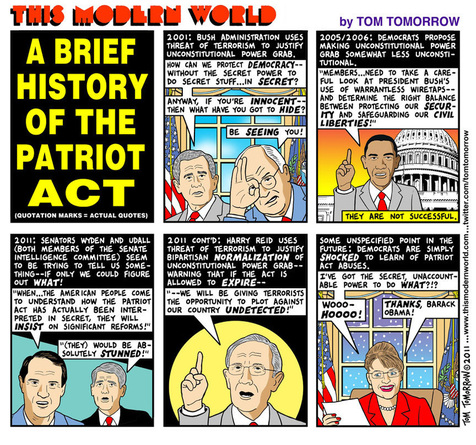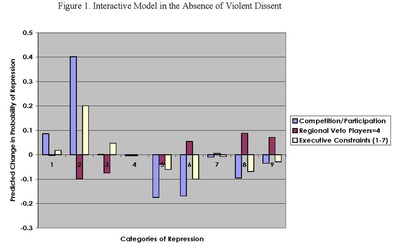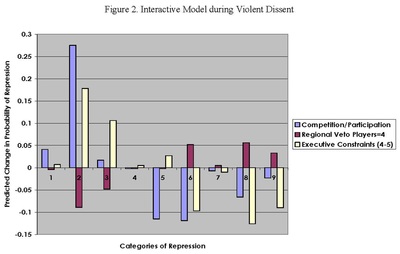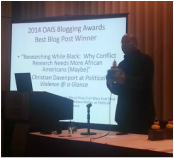What did we know(ish)?
Based on now classic research in international relations, for decades researchers have found that political democracy generally decreases state repression by increasing the costs of such activity (the predominate explanation) and/or by providing alternatives mechanisms for control (an explanation not advanced that frequently but hinted at).
What we really didn’t know well?
Although the work preceding 2007 significantly advanced the field from what had been before, there are some limitations with this literature (as well as that which followed – discussed later). Four in particular stand out:
- Different aspects of repression exist:
- There are violent forms (e.g., torture, disappearances, mass killing)
- There are non-violent forms (e.g., restrictions on speech, assembly, association, movement, domestic spying);
- Different aspects of democracy exist:
- “Voice”: mass participation in the political system, representativeness of party system;
- “Veto”: institutional mechanisms and elites which block, delay or override particular policies;
- Regional contexts vary:
- Some locales are surrounded by other democracies which would enhance democratic norms;
- Some locales are surrounded by non-democracies which would undermine democratic norms;
- The conflict situation varies:
- In some places there is violent contention (e.g., riots, guerilla warfare, terrorism);
- In some places there is civil war; and,
- In some places there is interstate war
These each challenge prior literature. For example,
- The domestic democratic peace might only work for certain forms of repression;
- The domestic democratic peace might only work for certain forms of democracy;
- The domestic democratic peace might only work within certain political contexts; and,
- The domestic democratic peace might only work within certain conflictual contexts.
State Repression and the Domestic Democratic Peace (hereafter SR-DDP)
- In 2007, I sought to overcome the limitations identified above with an examination of 137 countries from 1976-1996. While the work was somewhat well received at the time, it did not dramatically influence much scholarship that followed it because the four limitations noted above have largely gone untested – of special note here is the fourth point concerning the subversive power of political threats/behavioral challenges on the pacifying influence of democracy. Indeed, I would venture to say that since the book was published only one piece has looked for the interactive impact of democracy and behavioral challenges on state repression/human rights violation (i.e., Conrad and Moore). This work finds the same thing that SR-DDP does: when a threat is present (in their case, violent dissent), the pacifying impact of democracy goes away.
What Did SR-DDP Find and Why is it Useful to go All the Way Back to 2007?
- Well, generally Voice (specifically, the competition/participation measure) is more potent in reducing repression relative to Veto (specifically, the executive constraints measure). That is, when citizens have the right to vote, when they vote in large numbers and when diverse interests receive representation this has greater influence on reducing government coercive/forceful action than when diverse restrictions are placed on authorities and when specific limitations exist within very precise domains such as the legislature.
- In addition to this, SR-DDP finds that democracy is better at influencing less lethal activities than those that are the most lethal. Political democracy is not very good at addressing the worst of the worst that states do.
- Democratic regions facilitate democratic peace – albeit not as strong as we would anticipate.
- Perhaps most important, SR-DDP finds that the Domestic Democratic Peace is subverted/undermined when behavioral challenges/political conflict is considered:
- In contrast, civil war produces somewhat mixed results. In these contexts, the pacifying influence of Competition/Participation increases but the pacifying influence of Executive Constraint is diminished.
- In situations of interstate war, most democratic characteristics improve in their capacity to reduce state repression.
What are the Major Takeaways from this Work?
There are two of note:
- 1) In our efforts to diminish state repression/human rights violation, it is important that people have the vote, it is important to increase the number of people participating in the electoral system/contests that take place and it is important to increase the representative nature of the political choices placed before the population (this should be sounding familiar).
- 2) While democracy is a reasonable strategy that can reduce state repression, however, this strategy is not without its limitations. For example,
- Despite the best of intentions, democracy does not seem to be able to diminish the most violent activities that governments engage in;
- It is not clear why different forms of conflict/contention wield differential impacts on the pacifying influence of democracy;
- It is not clear why violent dissent weakens diverse democratic characteristics uniformly, while civil war produces mixed influences and interstate war tends to strengthen the domestic democratic peace; and,
- It is not clear why democratic neighborhoods somewhat imbalanced with regard to their influences.
What Next/Now as we Prepare for the New President/Context?
Recent events are sobering but they also provide an opportunity. Perhaps now we will have some attention being given to the possibility and dynamics of repression/human rights violation taking place in democracies in general and the United States in particular. There was an older debate with scholars who I will not name (for they never cite/use mine) which maintained that democracy and repression/human rights violation were the same thing but if American history across the anti-Anarchist campaign, against the Japanese and German-American populations during World War II, against the Communist Party following the great war, against the American Civil Rights and Black Power Movements, against the environmental movement, against the Old and New(er) left did and during the “War on Terror” is not convincing enough that the two concepts are distinct from one another, then perhaps the wave of anticipated activities will further reveal the differences. We of course have very detailed scholarship about prior coercive/forceful activities in the United States and this work should now be dusted off and put into everyone’s syllabi, reading lists, blog posts and instagram updates. I will post a reading guide to US repression soon.
And to be clear, I am not simply suggesting revisiting my Domestic Democratic Peace book (conveniently summarized in this unpublished article) for we all know that most of social science is forward looking, ever forward (you might get a reference to something older than 10 years but it will most likely not be used as the core theoretical premise of the work). We need to get past that thing as well. The SR-DDP just provides a useful starting point.
For example, my book merely focused on overt, somewhat obvious behavioral challenges. What was used to mobilize individuals and groups to vote in the last election and what will be used to motivate government and non-governmental activities to restrict civil liberties and violate personal integrity (with wide support mind you) after the new President is installed is a constructed threat composed of diverse individuals/groups and actions. This drills down into the main correlation found in the Domestic Democratic Peace.
Moving in this direction, we are treading in some water here that has already been addressed. Indeed, as Darren Davis’ work tells us one of the reasons why individuals in a democracy are perfectly fine with state repression/human rights violation and they not only don’t punish leaders that use it but praise them for it, is because the authorities are answering a problem; they are heading a call. Now, whether the leaders are responding to a call and/or prompting it is a different matter entirely but this is just the type of discussion, data collection and analysis that we need to engage in as we move into/through january.
This still begs the bigger question though: how does the political idea and institution that we so frequently and broadly associate with non-violence, cooperation, negotiation, reason and the protection of its citizens (i.e., political democracy) end up potentially being the instrument of violence, hostility, aggression and a threat to individuals living in the territorial jurisdiction? Or, have we been somewhat off and the political institution always a threat (like the old Anarchists like Malatesta and Kropotkin told us or as James Scott more recently got into).
Other work or revisitation would be useful as well. For example, it is not clear SR-DDP what the specific mechanism was that driving the relevant finding – are leaders taking advantage of an opportunity to push forward repressive action or are political authorities following the lead provided by citizens? We are not without some research on this. For example, see James Gibson’s earlier work on the topic. We simply need more on this and soon.
Finally, it is not clear how and why relevant activities might vary over time and space within a democracy. My earlier work was aggregated to the nation-year and my subsequent disaggregated investigations have been more about contentious politics than democracy. Anyone who has had their eyes go blurry looking at blue and red across the United States should be wondering exactly how things are going to be playing out over this context.




 RSS Feed
RSS Feed
